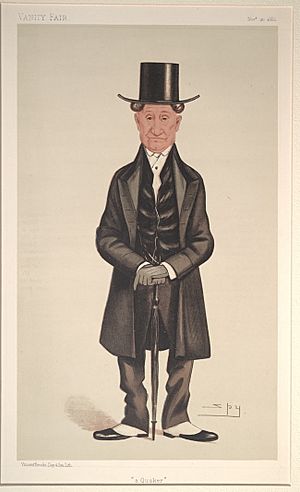Edmund Sturge facts for kids
Edmund Sturge (born December 8, 1808 – died June 28, 1893) was a Quaker businessman. He was also a strong supporter of many good causes. He worked to make the world a better place.
Contents
Early Life and Family
Edmund Sturge was born in Olveston, near Bristol. He was the youngest of twelve children. His parents were Joseph Sturge (1752–1817) and Mary Marshall.
His older brother, Joseph Sturge, was very active in the movement to end slavery in the United Kingdom. Their cousin, Thomas Sturge, also worked against slavery. Edmund went to school at James Moxham's and R. Weston's. Both of his parents died by the time he was 11 years old. During holidays, he often stayed with his brother Joseph. He helped out in Joseph's business, which dealt with corn.
After school, Edmund moved to Birmingham. He lived with his brother Joseph and his brother John. Edmund helped with the books for John's chemical factory. When he was old enough, he became a partner in the business, called J & E Sturge.
Edmund Sturge cared deeply about many important issues. He worked to end slavery and promote peace. He also supported prison reform. He wanted to stop the opium trade and helped the Aborigines' Protection Society. This group worked to protect native peoples around the world.
Fighting Against Slavery
In 1837, Edmund's brother Joseph returned from a trip to the West Indies. Joseph had seen the terrible conditions of enslaved people. Edmund helped to share Joseph's report widely. This report showed everyone how bad slavery was.
In 1840, Edmund joined a new group called the British and Foreign Anti-Slavery Society. He became part of its main committee in 1860. Later, he served as the Society's Secretary from 1870. He was the chairman from 1882 to 1891. After that, he was a vice-president until he died.
After he stopped working in business in 1876, he often spoke to Parliament (the UK's government). He talked about the Society's goals. In 1893, he wrote a short book. It was about the money paid to slave owners when slavery ended.
The Times newspaper wrote about Edmund Sturge when he died. They said he was a quiet but steady worker against slavery for over 60 years. Many changes in the West Indies that helped formerly enslaved people were thanks to him.
Chemical Business Success
Edmund's brother, John Sturge (1799–1840), was also important. In 1814, John learned about pharmacy and chemistry. He worked for a successful Quaker chemist in London.
John Sturge started his own business. He made chemicals like verdigris (a green pigment) and a solution of tin. These were used by people who dyed fabrics. Around 1823, he moved his business to Edgbaston, Birmingham.
Edmund joined John in the business after finishing school. Their company was called J. and E. Sturge & Co. In 1831, they built a larger factory. They made many industrial chemicals. These included citrates, tartrates, bicarbonate of potash, and precipitated chalk.
When John Sturge died in 1840, Arthur Albright joined the company. Arthur was a trained chemist and Edmund's brother-in-law. Arthur Albright found ways to make large amounts of white phosphorus. He later made a safer type called "red" phosphorus. This was used to make matches. Arthur later started his own company, which became Albright and Wilson.
The Montserrat Connection
The Sturge factory needed a lot of citrus juice to make citric acid. They usually got lemons from Sicily. But the supply of lemons could change a lot.
Edmund's brother, Joseph, had supported growing limes on the Caribbean island of Montserrat. This led to the Sturge family owning a lot of land on Montserrat. They ran their estates well. They paid their workers fairly for many years.
In 1867, Edmund and Lydia Sturge traveled to Montserrat. They spent a year helping to grow limes there. This project later became the Montserrat Lime Juice company. Edmund Sturge was a director of this company until he died. His son, John Edmund, and daughter, Edith, also helped manage the Montserrat estates.
Marriage and Family Life
Edmund Sturge married Lydia Albright in 1841. She was the daughter of William and Rachel Albright. Lydia was already involved in good causes. She wanted to replace war with peaceful talks. She also helped people who were poor. Lydia was part of the Ladies' Negro's Friendly Society. She later became its Secretary. She supported Edmund in all their projects throughout their marriage.
Edmund and Lydia had five children:
- John Edmund, born April 3, 1842. He married Jane Richardson. He died in Montserrat in 1880, when he was 38.
- Edith Mary, born October 26, 1843. She married James Spencer Hollings in 1868.
- Francis Albright, born August 28, 1845.
- Eleanor, born August 6, 1848.
- Margaret, born August 20, 1850. She married Lewis Sturge, and later Colin Campbell Scott Moncrieff.
Lydia Sturge passed away on December 19, 1892.
Death
Edmund Sturge died on June 28, 1893. He was 84 years old. He passed away in Charlbury.
See also


